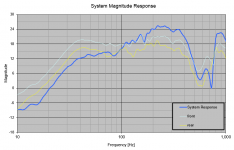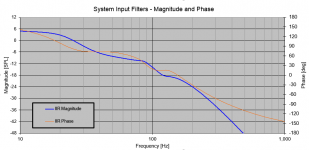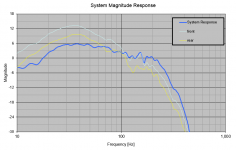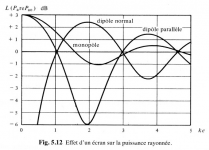Hello Charlie. Congratulations. The design looks deceptively simple, do you use the M-frame for a degree of force cancellation and slightly smaller cabinet, or does it have any other benefits over an H-frame? I'm intrigued to know what kind of EQ was used to get down to 20 Hz.
I tried to keep the design as simple as possible. I do not think you can get any simpler if you want a wide band dipole!
I am very bad at making cabinets, and woodwork in general. Sometimes I try to use a pre-finished product. In the case of the M-frame, I had some IKEA kitchen cabinet frames lying around that I decided I would use for the bass section. Originally I had set them up with a single Alpha 15A as an H-frame and done some measurements that encouraged me to forge ahead with the drivers. But I realized that if I had two per side I could exactly fit them into the existing cabinet as an M-frame with a 90 degree angle between the two panels of the "M". The Alpha 15A does not have a very high Xmax of ~4.5mm and I was concerned that I would run out of it if I wanted to get deep bass. Having two per side doubles the total swept volume and because the drivers are 8R I could parallel them to get +6dB voltage sensitivity. All of this seemed to be a good plan, and would help to offset dipole losses, etc. That's how the sub came together.
In the larger meeting space where the speakers were demoed (a hotel conference space) the bass was impressive. It seems very possible to use just one of the M-frames and create a 2.1 (mono sub plus stereo MT) system with plenty of low end. This is one of the configurations that I am thinking of developing, but it would still require a room of a certain size for the bass to work. For smaller rooms, replacing the M-frame with a closed box sub and dropping the crossover point of the 15" mid to 150Hz would be a better approach. This is another potential configuration. In both cases I would keep the existing midrange and tweeter arrangement, and come up with a slimmer mounting system for each of them. I am currently ruminating on some ideas for that.
Regarding the DSP used on the M-frame, I have attached a couple of screen shots (from left to right):
* M-frame response without filters (SPL is arbitrary)
* the EQ/filter curve I applied
* the response with the EQ+filters (SPL is arbitrary)
Thanks to the high Qts of the drivers I only apply about 6dB of boost to extend the low end a bit. This allows me to get a response that has an F3 of about 20Hz. One attractive aspect of this kind of subwoofer is that the driver's resonance frequency when installed in the M-frame is about the same or a little less than its free air Fs, and Qts is about the same or a little higher (depending on the depth of the 'frame).
.
Attachments
Also, here is my best guesstimate on the sensitivity of the system:
Each Alpha 15A has about 94dB/W sensitivity at around 200Hz (see MFG data sheet). The M-frame uses two of these drivers in parallel, which elevates the sensitivity by +6dB for an effective sensitivity of around 100dB/W.
In the M-frame, both a resonance and the dipole response peak give rise to a peak in the response of around +6dB on axis SPL compared to the SPL that would be obtained if the driver was mounted in an infinite baffle. This occurs between 200 and 300 Hz in the first (leftmost) plot in the post above, so in this region the on-axis SPL level of the M-frame is around 106dB/W (on axis). There is about a 12dB difference between the level between 250Hz and 40Hz, so at 40Hz the native SPL is around 92dB/W. That's pretty good for this kind of system and modest amplification is all that is needed.
Also, by looking at the unfiltered response you can see that even without any low frequency boost you could obtain an F3 of around 35Hz just by attenuating the response above 100Hz or so. It might be possible to implement such a correction using a passive filter, but it would require one or more pretty large inductors since the response rises at about 12dB/oct beginning at about 90Hz.
Each Alpha 15A has about 94dB/W sensitivity at around 200Hz (see MFG data sheet). The M-frame uses two of these drivers in parallel, which elevates the sensitivity by +6dB for an effective sensitivity of around 100dB/W.
In the M-frame, both a resonance and the dipole response peak give rise to a peak in the response of around +6dB on axis SPL compared to the SPL that would be obtained if the driver was mounted in an infinite baffle. This occurs between 200 and 300 Hz in the first (leftmost) plot in the post above, so in this region the on-axis SPL level of the M-frame is around 106dB/W (on axis). There is about a 12dB difference between the level between 250Hz and 40Hz, so at 40Hz the native SPL is around 92dB/W. That's pretty good for this kind of system and modest amplification is all that is needed.
Also, by looking at the unfiltered response you can see that even without any low frequency boost you could obtain an F3 of around 35Hz just by attenuating the response above 100Hz or so. It might be possible to implement such a correction using a passive filter, but it would require one or more pretty large inductors since the response rises at about 12dB/oct beginning at about 90Hz.
Dipole Power Radiation transition from half to full space
Loudspeakers are often placed on the floor, which forms a large wall. Unlike in monopoles, the radiated acoustic power of dipoles behave quite critical in theirs frequency and distance dependent transition from halfspace to fullspace.
An acoustically large wall near a point source alter it’s radiation impedance, making the radiated acoustic power dependent from the distance (e) to the wall and from the frequency, here as the term k.
k=2pi/lambda.
One of the nearest large walls for a loudspeaker is the floor. So, what does that mean? Have a look at the graph.
As a first and simple example, look at the monopole’s radiated power along ke.
Pa=Pam[1+(sin2ke/2ke)] Pam is the power radiated by the driver in free space.
A monopole’s power radtiation gently swings from Pa=2*Pam at ke=0 to Pa=Pam at a very large ke within a sine and an attenuation mode. In other words: Close to the wall it has a double power radiation than far away from this wall. The tranistion between these two extremes is uniformly oscillating in a damped mode.
A dipole’s radiated power is quite a different and more complex stuff. Have a look at the graph again. Unfortunately I don’t have the exact formulas – can anyone provide them? Would be great.
A dipole standing on the floor forms a parallel dipole related to the floor. It’s power radiation swings like mad compared to the monopole. Have a look at the corresponding curve – the radiated power starts at Pa=2Pam at ke=0, begins to dive, reaches Pa=Pam at ke=1.05 (approx), and dives to Pa=0.25 at ke=1.95 (approx). At the extremes, very close and far away from the wall, a parallel dipole behaves like a monopole.
A dipole standing in front of a wall forms a normal dipole. It’s power radiation characteristic is somewhere complementary/symmetric to the one of the parallel dipole: 0 at ke=0, 1 at ke=1.05, and a first maximum at ke=1.95. Unlike the monopole and the parallel dipole, the normal dipole has a power radiation of null very close to the wall.
So, compared to a monopole driver, the placement of a dipole driver in relation to a wall is much more critical. But nevertheless, the complementary symmetry nature of radiated power for a parallel and a normal dipole offers some workaround, and shows why it is a good advice in an listening environment to toe in dipole speaker to some 45° related to the front wall. This manoever brings the otherwise normal dipole into a more mixed normal-parallel radiation mode. And this ttranslates into an approached complementary mix of cancellation and augmentation of the radiated power.
Toeing in a parallel dipole (related to the floor) is also possible, but certainly less practical. So, what does this mean now for the construction of a fullrange dipole speaker array? Let’s look e.g. at a typical construction with a lower-mid driver at an elevation of 50cm from the floor.
k=2pi/lambda
tranlates to a value of ke=1.95 for a floor-distance of 50cm and a frequency of 214Hz. This driver will have it’s 0.25 acoustic-power-notch right there, where it should shine. What a mismatch! Similarly at 40cm the notch will be at 267Hz, at 60cm at 178Hz (these values are close approximates - who, please, has the exact formula for the parallel dipole?).
Therefore, construction a dipole fullrange some care has to be taken in regard of the vertical array – you will have to match the height of a driver above floor along with the frequency band to be radiated by this driver. As a rule of thumb, drivers should be placed in the range for ke<1.2 and ke>2.7.
And be aware that you cannot match the smoothness of a monopole’s power radiation with a dipole setup. Encountering ke’s>1.2 … ke<4.2 won’t let it happen.
Ceterum censeo: Can anyone provide the exact formula for the parallel dipole?
Loudspeakers are often placed on the floor, which forms a large wall. Unlike in monopoles, the radiated acoustic power of dipoles behave quite critical in theirs frequency and distance dependent transition from halfspace to fullspace.
An acoustically large wall near a point source alter it’s radiation impedance, making the radiated acoustic power dependent from the distance (e) to the wall and from the frequency, here as the term k.
k=2pi/lambda.
One of the nearest large walls for a loudspeaker is the floor. So, what does that mean? Have a look at the graph.
As a first and simple example, look at the monopole’s radiated power along ke.
Pa=Pam[1+(sin2ke/2ke)] Pam is the power radiated by the driver in free space.
A monopole’s power radtiation gently swings from Pa=2*Pam at ke=0 to Pa=Pam at a very large ke within a sine and an attenuation mode. In other words: Close to the wall it has a double power radiation than far away from this wall. The tranistion between these two extremes is uniformly oscillating in a damped mode.
A dipole’s radiated power is quite a different and more complex stuff. Have a look at the graph again. Unfortunately I don’t have the exact formulas – can anyone provide them? Would be great.
A dipole standing on the floor forms a parallel dipole related to the floor. It’s power radiation swings like mad compared to the monopole. Have a look at the corresponding curve – the radiated power starts at Pa=2Pam at ke=0, begins to dive, reaches Pa=Pam at ke=1.05 (approx), and dives to Pa=0.25 at ke=1.95 (approx). At the extremes, very close and far away from the wall, a parallel dipole behaves like a monopole.
A dipole standing in front of a wall forms a normal dipole. It’s power radiation characteristic is somewhere complementary/symmetric to the one of the parallel dipole: 0 at ke=0, 1 at ke=1.05, and a first maximum at ke=1.95. Unlike the monopole and the parallel dipole, the normal dipole has a power radiation of null very close to the wall.
So, compared to a monopole driver, the placement of a dipole driver in relation to a wall is much more critical. But nevertheless, the complementary symmetry nature of radiated power for a parallel and a normal dipole offers some workaround, and shows why it is a good advice in an listening environment to toe in dipole speaker to some 45° related to the front wall. This manoever brings the otherwise normal dipole into a more mixed normal-parallel radiation mode. And this ttranslates into an approached complementary mix of cancellation and augmentation of the radiated power.
Toeing in a parallel dipole (related to the floor) is also possible, but certainly less practical. So, what does this mean now for the construction of a fullrange dipole speaker array? Let’s look e.g. at a typical construction with a lower-mid driver at an elevation of 50cm from the floor.
k=2pi/lambda
tranlates to a value of ke=1.95 for a floor-distance of 50cm and a frequency of 214Hz. This driver will have it’s 0.25 acoustic-power-notch right there, where it should shine. What a mismatch! Similarly at 40cm the notch will be at 267Hz, at 60cm at 178Hz (these values are close approximates - who, please, has the exact formula for the parallel dipole?).
Therefore, construction a dipole fullrange some care has to be taken in regard of the vertical array – you will have to match the height of a driver above floor along with the frequency band to be radiated by this driver. As a rule of thumb, drivers should be placed in the range for ke<1.2 and ke>2.7.
And be aware that you cannot match the smoothness of a monopole’s power radiation with a dipole setup. Encountering ke’s>1.2 … ke<4.2 won’t let it happen.
Ceterum censeo: Can anyone provide the exact formula for the parallel dipole?
Attachments
Hi Charlie,
I find all of this info very interesting! Please keep posting when you have more information!
Best regards, Erik
I find all of this info very interesting! Please keep posting when you have more information!
Best regards, Erik
I had a short discussion with Earl Geddes re baffle diffraction of dipole, this was the culmination https://www.diyaudio.com/forums/multi-way/317122-baffle-diffraction-60.html#post6001716
In both cases I would keep the existing midrange and tweeter arrangement, and come up with a slimmer mounting system for each of them. I am currently ruminating on some ideas for that.
Any problems with magnet mounting?
I don't agree - the floor reflection generates the "phantom source" for a monopole, however, for a dipole the floor is in the null of the dipole and therefore little radiation is available to form a reflection. In fact, I can use a very long gating time indoors if I measure a dipole in a long room even if it is relatively narrow. This is because the side walls, ceiling, and floor are weakly illuminated if at all (there is not a perfect null formed at all frequencies except when there is a point source).A dipole standing on the floor forms a parallel dipole related to the floor.
OK, but this is also the case for a monopole. I would be careful about drawing conclusions about reflections in rooms. I get the idea you are treating the listener like he/she is a microphone. The ear+brain hearing system has evolved to perceive source characteristics in reverberant spaces and is a very sophisticated input processor. I would not worry so much about rear-wall reflections, in fact they seem to add to the perceived soundstage for open baffle systems.A dipole standing in front of a wall forms a normal dipole.
I disagree. Both will be influenced by the wall to one degree or other, and there are situations to avoid. For both, avoid placing the speaker against the wall. For the dipole, a separation of 1m or more from any wall is best. If anything, a dipole will be less sensitive to room reflections because of the null in the radiation 90 degrees off axis from the main listening axis, where there are SIX surfaces in the path.So, compared to a monopole driver, the placement of a dipole driver in relation to a wall is much more critical.
Last edited:
Any problems with magnet mounting?
No, that is certainly a valid mounting method. I just don't prefer it in general.
I presume you mean the wall behind the speaker, usually referred to as the front wall?I would not worry so much about rear-wall reflections, in fact they seem to add to the perceived soundstage for open baffle systems.
I presume you mean the wall behind the speaker, usually referred to as the front wall?
Yes! Sorry I always seem to reverse "front" and "rear" wall.
Actually with a true dipole who knows...you might be listening to the back of the speaker 🙂
I'm so tempted by your idea, how important do you think room size is and why? I tend to listen to my OB's (I hesitate to call them dipoles) nearfield.
I'm so tempted by your idea, how important do you think room size is and why? I tend to listen to my OB's (I hesitate to call them dipoles) nearfield.
...I would not worry so much about rear-wall reflections, in fact they seem to add to the perceived soundstage for open baffle systems....
Thinking about dipoles goes way way back in the ESL world although some ESL tweeters have avoided rear radiation. The general consensus among ESL users seems to be that rear radiation is a good thing, just like with real music instruments.
Wanting to focus on front radiation appeals to those who find conceptual simplicity an appealing audio quality.
Back when I used to have drivers in boxes, I found taking the back off improved the sound.
See post 40:
Quad 2805 dust cover problem
B.
Last edited:
Actually with a true dipole who knows...you might be listening to the back of the speaker 🙂
I'm so tempted by your idea, how important do you think room size is and why? I tend to listen to my OB's (I hesitate to call them dipoles) nearfield.
Dipole sources cannot pressurize. In small rooms this can make the bass seem anemic. The same system in a larger room may have more bass then in a smaller room. Sitting in the very nearfield will reduce this effect because the rear source will be relatively less intense than the front source, and the response at the near listening position is trending towards the infinite baffle response. This same phenomenon (distance dependence) influences the polar pattern that the dipole speaker can develop, and in the nearfield (e.g.<1m) the pattern will break down compared to the far field (e.g. >3m).
Dipole sources cannot pressurize. In small rooms this can make the bass seem anemic....
The simplified textbook image of a dipole isn't quite the right story for a largish, irregular baffle in a real room. The textbook Euclidean model doesn't fit well with the wild gyrations of phase in the real world.
My experience with a largish irregular shaped baffle was pretty satisfactory. Maybe I should try to dig out my plots. Anybody got data rather than textbook theories?
BTW, no such thing as "pressurize" except in well sealed VW cars of 1960.
B.
I'm not sure what is meant exactly by pressurize, something to do with how room modes are excited? My room is 12' by 15' pretty much arranged as suggested by Linkwitz except the listening triangle is about 6'. I guess I'm stuck in midfield most of the time 😉Dipole sources cannot pressurize. In small rooms this can make the bass seem anemic. The same system in a larger room may have more bass then in a smaller room. Sitting in the very nearfield will reduce this effect because the rear source will be relatively less intense than the front source, and the response at the near listening position is trending towards the infinite baffle response. This same phenomenon (distance dependence) influences the polar pattern that the dipole speaker can develop, and in the nearfield (e.g.<1m) the pattern will break down compared to the far field (e.g. >3m).
Below the room fundamental the room can be though of as a big, leaky box. So a sealed box woofer is a woofer in a box, in a bigger box. Just as the pressure inside the woofer box changes as the cone moves in and out, the same thing happens in a room below the fundamental due to the net volume change. This can boost bass response below the room fundamental. With a dipole, since the is no woofer box to isolate the rear of the cone, there is no net change in room volume as the cone moves, thus, no pressurization.
"Dipole" speakers in a small room near boundaries is an interesting topic. Much of discussion seems to be purely theoretical based on the assumption that radiation pattern is true ideal dipole in 3D. This is however not realistic! Then add the listener position and psychoacoustics!
Sitting in nearfield, direct response dominance overrules most issues, but who really does that for enjoyment, pleasure, at home? For that may I suggest modern boxed 2-way coaxials with sub(s) or simply just headphones!
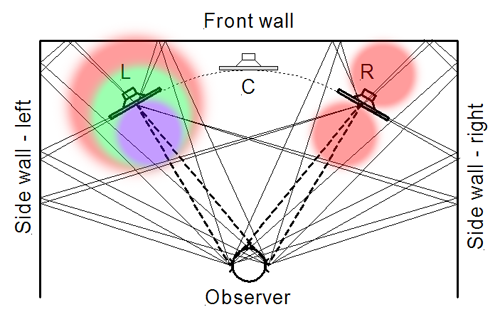
Some articles
Room Acoustics
http://linkwitzlab.net/AES'07/AES123-final2.pdf
Boundary effects
Cardioid bass
Sitting in nearfield, direct response dominance overrules most issues, but who really does that for enjoyment, pleasure, at home? For that may I suggest modern boxed 2-way coaxials with sub(s) or simply just headphones!

Some articles
Room Acoustics
http://linkwitzlab.net/AES'07/AES123-final2.pdf
Boundary effects
Cardioid bass
Last edited:
So, compared to a monopole driver, the placement of a dipole driver in relation to a wall is much more critical.
And be aware that you cannot match the smoothness of a monopole’s power radiation with a dipole setup. Encountering ke’s>1.2 … ke<4.2 won’t let it happen.
Ceterum censeo: Can anyone provide the exact formula for the parallel dipole?
BRAVO !! It's so refreshing to see some truth !!
Below the room fundamental the room can be though of as a big, leaky box. So a sealed box woofer is a woofer in a box, in a bigger box. Just as the pressure inside the woofer box changes as the cone moves in and out, the same thing happens in a room below the fundamental due to the net volume change. This can boost bass response below the room fundamental. With a dipole, since the is no woofer box to isolate the rear of the cone, there is no net change in room volume as the cone moves, thus, no pressurization.
No pressurization and NO BASS from an open baffle. Check out the typical response on an IEC baffle, which is most likely a bit larger than what the OB "enthusiasts" use. 30Hz is 30db down, relative to 100, but how many times have I heard that OB bass is the bomb ? (too many)
What is a Frequency Response Chart? | Jensen Loudspeakers
- Home
- Loudspeakers
- Multi-Way
- In Pursuit of a 20-20k Dipole Loudspeaker
